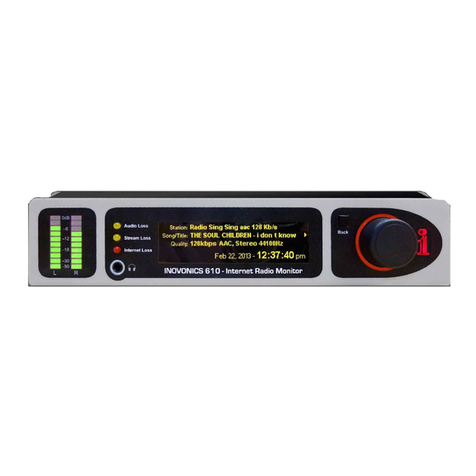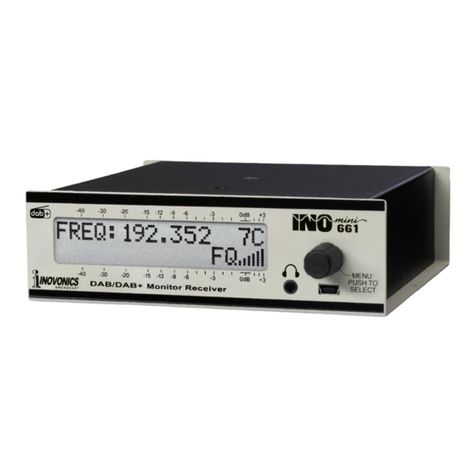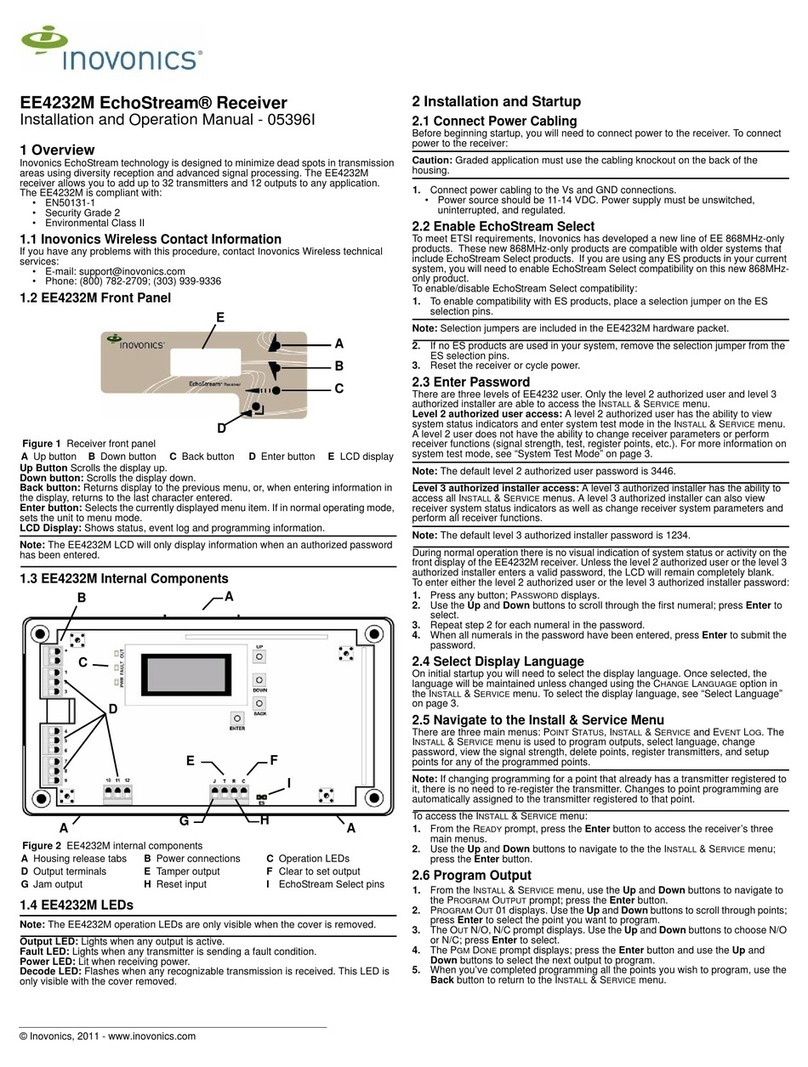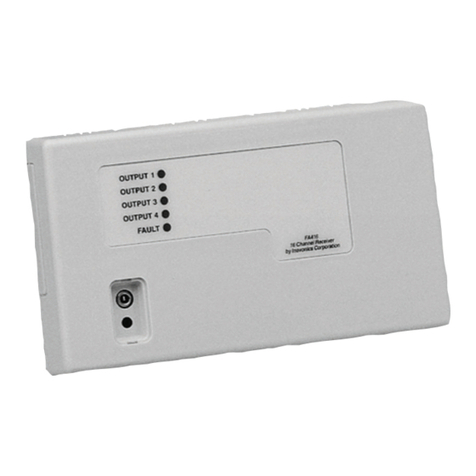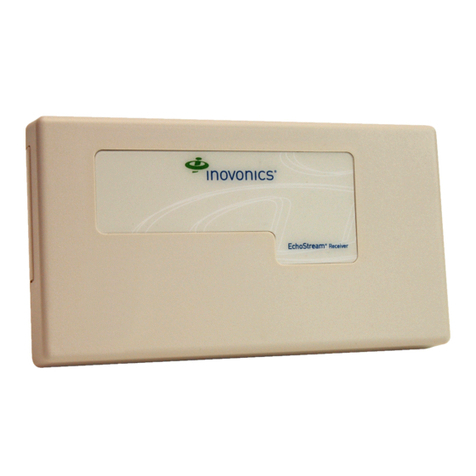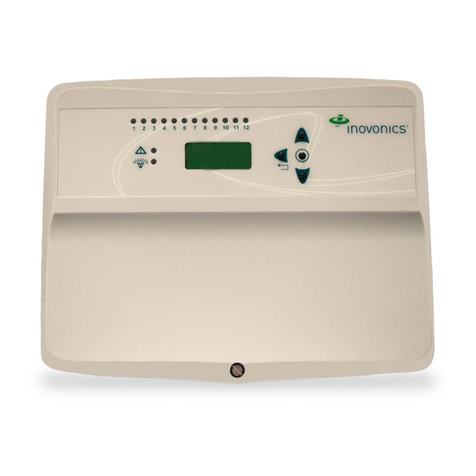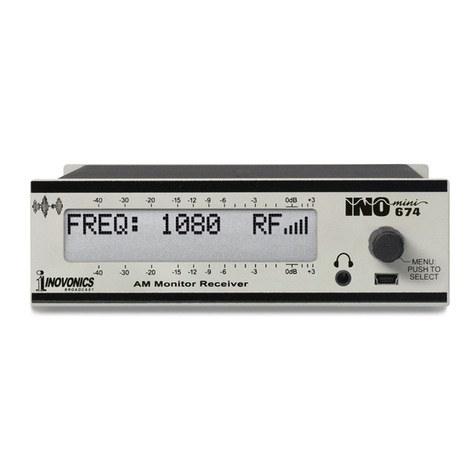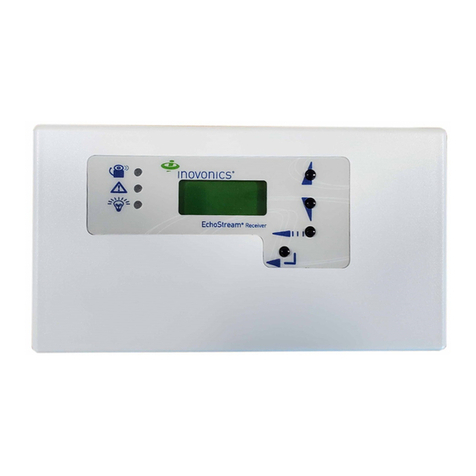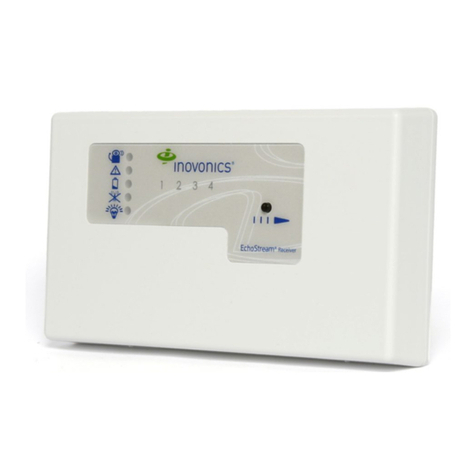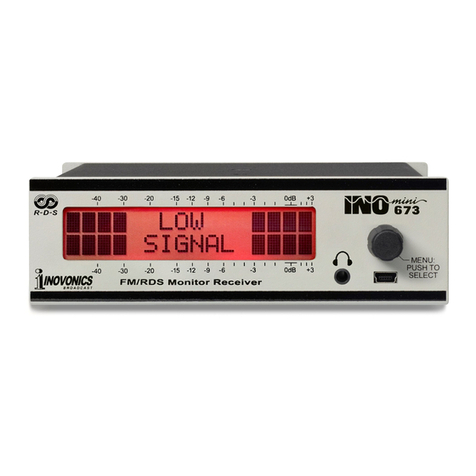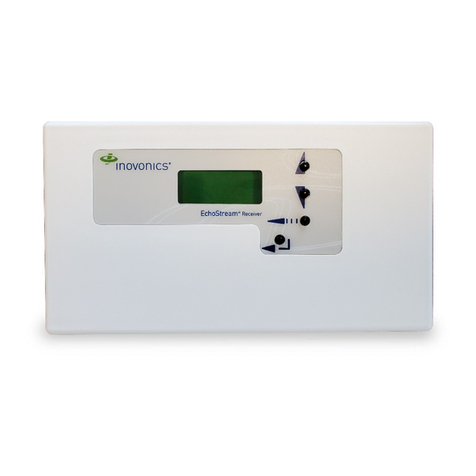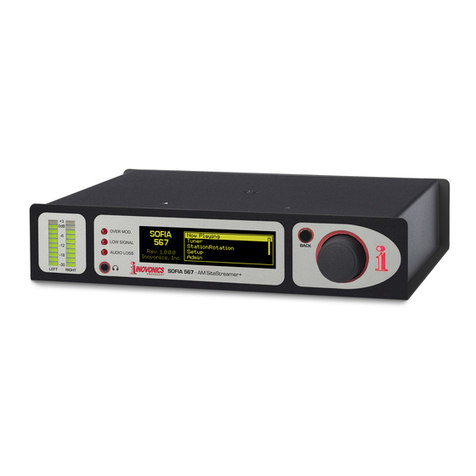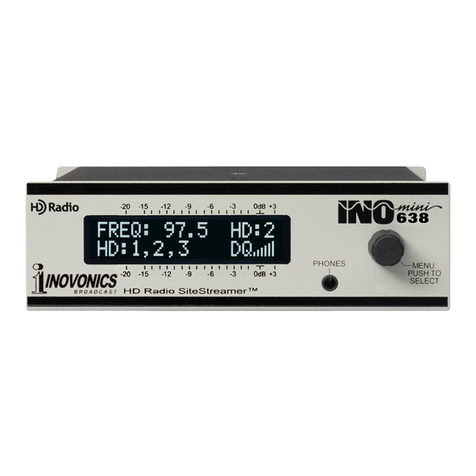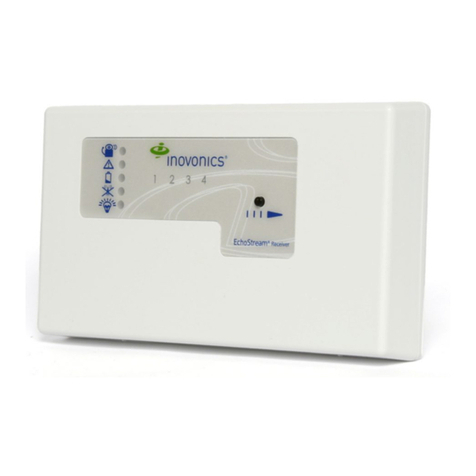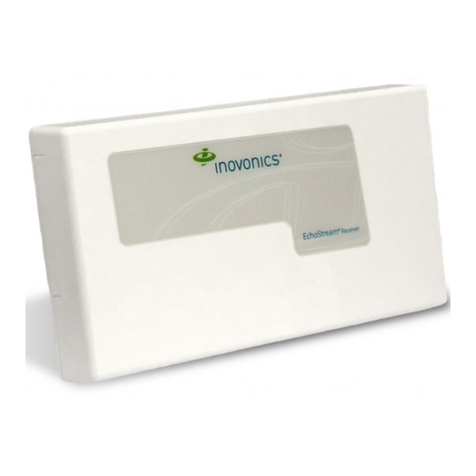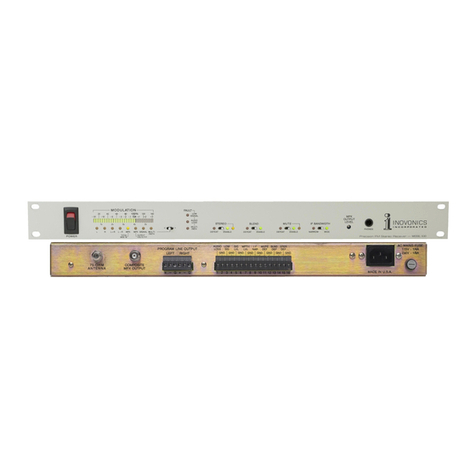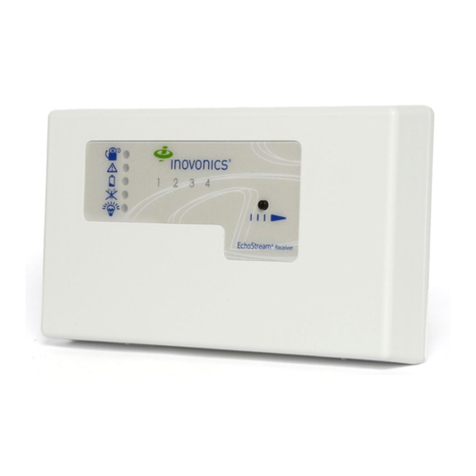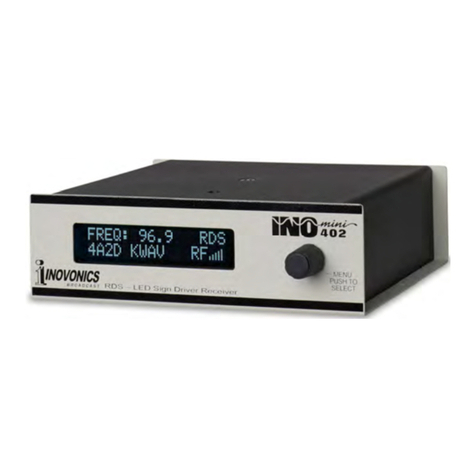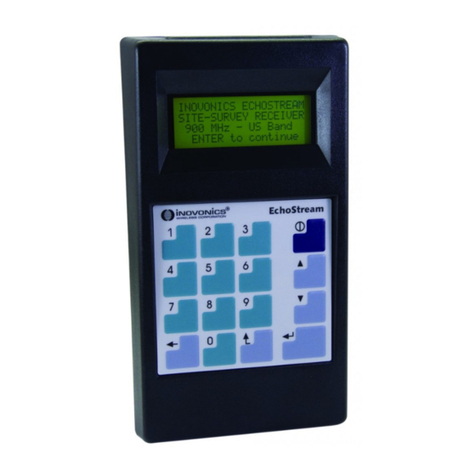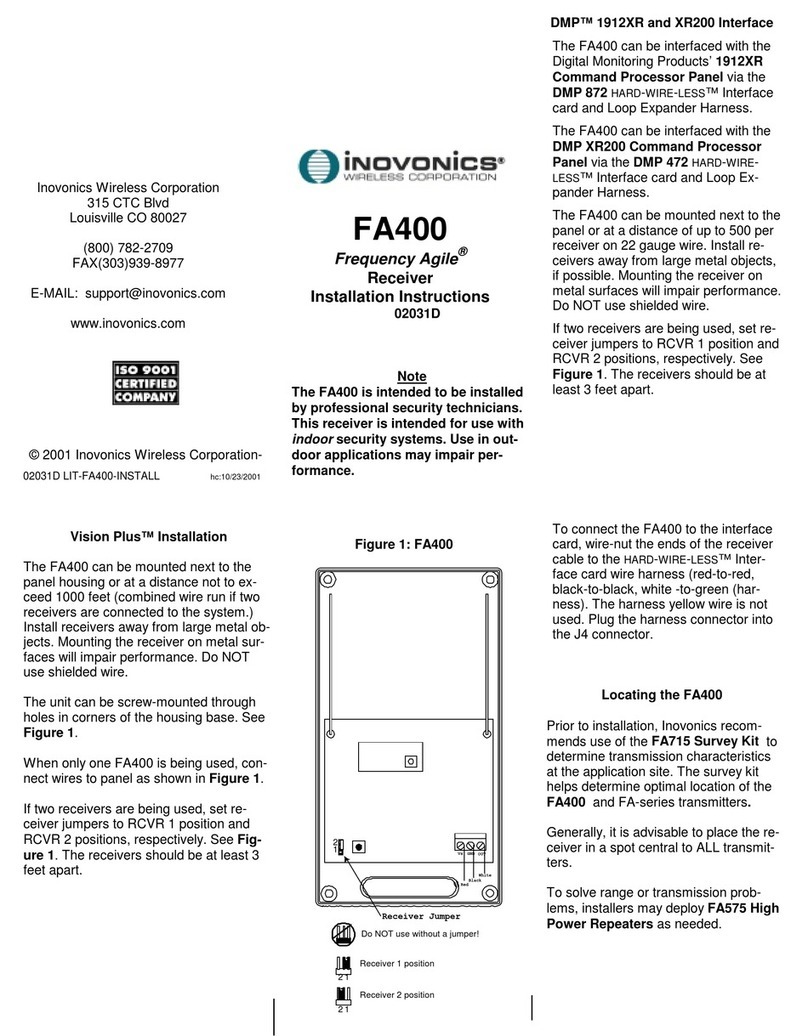
4.2.20 357-05396-01 Rev A © Inovonics, 2020 - www.inovonics.com 4
Tamper Out: Maps transmitter/repeater tamper fault output.
a. Use the Up/Down buttons to scroll through the output numbers.
Choosing - - will disable tamper output.
b. Press Enter to select the output to use for this transmitter/repeater's
tamper transmission.
Tamper Output Type Selects the output type for the tamper condition.
a. Use the Up/Down buttons to scroll through the following options:
• Follower: The output reflects the transmitter’s tamper status. Press
the Enter button to select.
• Latching: The output turns on when a tamper condition is sent and
remains on until the receiver is reset. Press the Enter button to select.
• Toggle: The output changes state each time the device sends a new
tamper condition. A minimum of five seconds must elapse before the
output can send a new tamper condition. Press the Enter button to
select.
INACTIVE displays when selected. Inactive time prevents output
chatter. The valid range is 2.0 to 99.5 seconds, in 0.5 second
increments. Use the Up and Down buttons to select; press the Enter
button to select.
• Momentary: The output turns on for the programmed duration, then
turns off, regardless of the device status. Press the Enter button to
select.
MOMENT displays when selected. This sets the time that the output will
stay activated. The valid range 0.5 to 99.5 seconds, in 0.5 second
increments. Use the Up and Down buttons to select; press the Enter
button to select.
Low Batt Out: Maps transmitter/repeater low battery fault output.
a. Use the Up/Down buttons to scroll through the output numbers.
Choosing - - will disable low battery output.
b. Press Enter to select the output to use for this transmitter/repeater's
low battery transmission.
Low Battery Output Type Selects the output type for the low battery
condition.
a. Use the Up/Down buttons to scroll through the following options:
• Follower: The output reflects the transmitter’s low battery status.
Press the Enter button to select.
• Latching: The output turns on when a low battery condition is sent and
remains on until the receiver is reset. Press the Enter button to select.
• Toggle: The output changes state each time the device sends a new
low battery condition. A minimum of five seconds must elapse before
the output can send a new low battery condition. Press the Enter
button to select.
INACTIVE displays when selected. Inactive time prevents output
chatter. The valid range is 2.0 to 99.5 seconds, in 0.5 second
increments. Use the Up and Down buttons to select; press the Enter
button to select.
• Momentary: The output turns on for the programmed duration, then
turns off, regardless of the device status. Press the Enter button to
select.
MOMENT displays when selected. This sets the time that the output will
stay activated. The valid range 0.5 to 99.5 seconds, in 0.5 second
increments. Use the Up and Down buttons to select; press the Enter
button to select.
Line Power Loss Out: Maps repeater line power loss fault output.
a. Use the Up/Down buttons to scroll through the output numbers.
Choosing - - will disable line power loss output.
b. Press Enter to select the output to use for this repeater's line power
loss transmission.
Line Power Loss Output Type Selects the output type for the line power
loss condition.
a. Use the Up/Down buttons to scroll through the following options:
• Follower: The output reflects the repeater’s line power loss status.
Press the Enter button to select.
• Latching: The output turns on when a line power loss condition is sent
and remains on until the receiver is reset. Press the Enter button to
select.
• Toggle: The output changes state each time the device sends a new
line power loss condition. A minimum of five seconds must elapse
before the output can send a new line power loss condition. Press the
Enter button to select.
INACTIVE displays when selected. Inactive time prevents output
chatter. The valid range is 2.0 to 99.5 seconds, in 0.5 second
increments. Use the Up and Down buttons to select; press the Enter
button to select.
Momentary: The output turns on for the programmed duration, then turns
off, regardless of the device status. Press the Enter button to select.
MOMENT displays when selected. This sets the time that the output will stay
activated. The valid range 0.5 to 99.5 seconds, in 0.5 second increments.
Use the Up and Down buttons to select; press the Enter button to select.
Text: Enter eight-character descriptive text for the transmitter/repeater
a. Use Up/Down buttons to scroll through the alphanumeric characters;
press Enter to select and advance to the next character. To select a
space, press Enter without selecting a digit.
Note: If you do not use all eight characters, you must enter spaces to the
end of the line.
b. When finished, press Enter again to complete selection.
4.6 Register Transmitter
The REGISTER TRANSMITTER option allows you to register a transmitter or
repeater.
a. Use the Up and Down buttons to toggle between N for no and Y for
yes to choose whether or not you wish to register a transmitter/repeater
to the point; press Enter to select.
Note: You can always register a transmitter/repeater to the point at a later
time using the REGISTER XMITTER prompt in the INSTALL & SERVICE menu.
b. If you chose to register a transmitter/repeater at this time, press the
transmitter/repeater’s Reset button at the RESET XMITTER prompt
c. If transmitters are registered, perform a walk test, activating each
transmitter assigned to the receiver and ensuring a good signal.
4.7 Delete Point
The DELETE POINT option allows you to delete transmitter registration
information from all registered points, or a specific point. Programmed point
information is not deleted; just the registration identification number
associated with the transmitters or repeaters. To delete points:
1. From the INSTALL & SERVICE menu, use the Up and Down buttons to
navigate to the DELETE POINT prompt; press the Enter button.
2. The DELETE ALL? prompt displays. Use the Up and Down buttons to
choose N for no or Y for yes; press Enter to select.
3. If you selected no, the DELETE POINT prompt displays. Use the Up and
Down buttons to select a point to delete; press Enter to select.
4. Press the Enter button to return to the INSTALL & SERVICE menu.
4.8 Monitor Signal Strength
The SIGNAL STRENGTH option is used to measure signal strength and
troubleshoot installation problems.
1. At the SIGNAL STRENGTH prompt, press Enter.
•P
OINT 01 displays, along with a signal quality of GOOD, WEAK or NO
SIG.
Note: The point must have an active transmitter associated with it to
display signal strength.
2. Use the Up/Down buttons to scroll through the registered transmitters.
3. Press Enter again to view Level (LV) and Margin (MA).
• LV indicates the overall signal strength; MA indicates the signal
strength minus the background noise.
4. To reset signal data, use the Up/Down buttons to leave and return to
the transmitter you are monitoring.
4.9 CTS Type
The EE4232M provides a signal to the control panel which can be used to
ensure all security devices in the system are active before allowing the
system to be set. If used by the control panel, the system cannot be set if
the receiver has not heard from any registered wireless devices within the
last 20 minutes.
Note: The CTS signal can be used to block alarming conditions. This is
useful when performing system tests. For more information on this see
“System Test Mode” on page 5.
The CTS TYPE option allows the clear to set signal to be set to either N/O or
N/C. To set the CTS type:
1. From the INSTALL & SERVICE menu, use the Up and Down buttons to
navigate to the CTS TYPE prompt; press the Enter button.
2. The CTS OP N/O, N/C prompt displays. Use the Up and Down buttons
to choose N/O or N/C; press Enter to select.
3. The CTS OP SAVED prompt displays; press the Enter button.
4. Use the Back button to return to the INSTALL & SERVICE menu.
4.10 Factory Config
The FACTORY CONFIG option is used to restore the EE4232M to its factory
defaults.
Caution: Choosing FACTORY CONFIG will erase all programmed point,
output, and language information.

